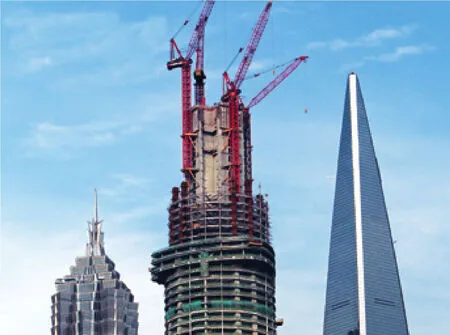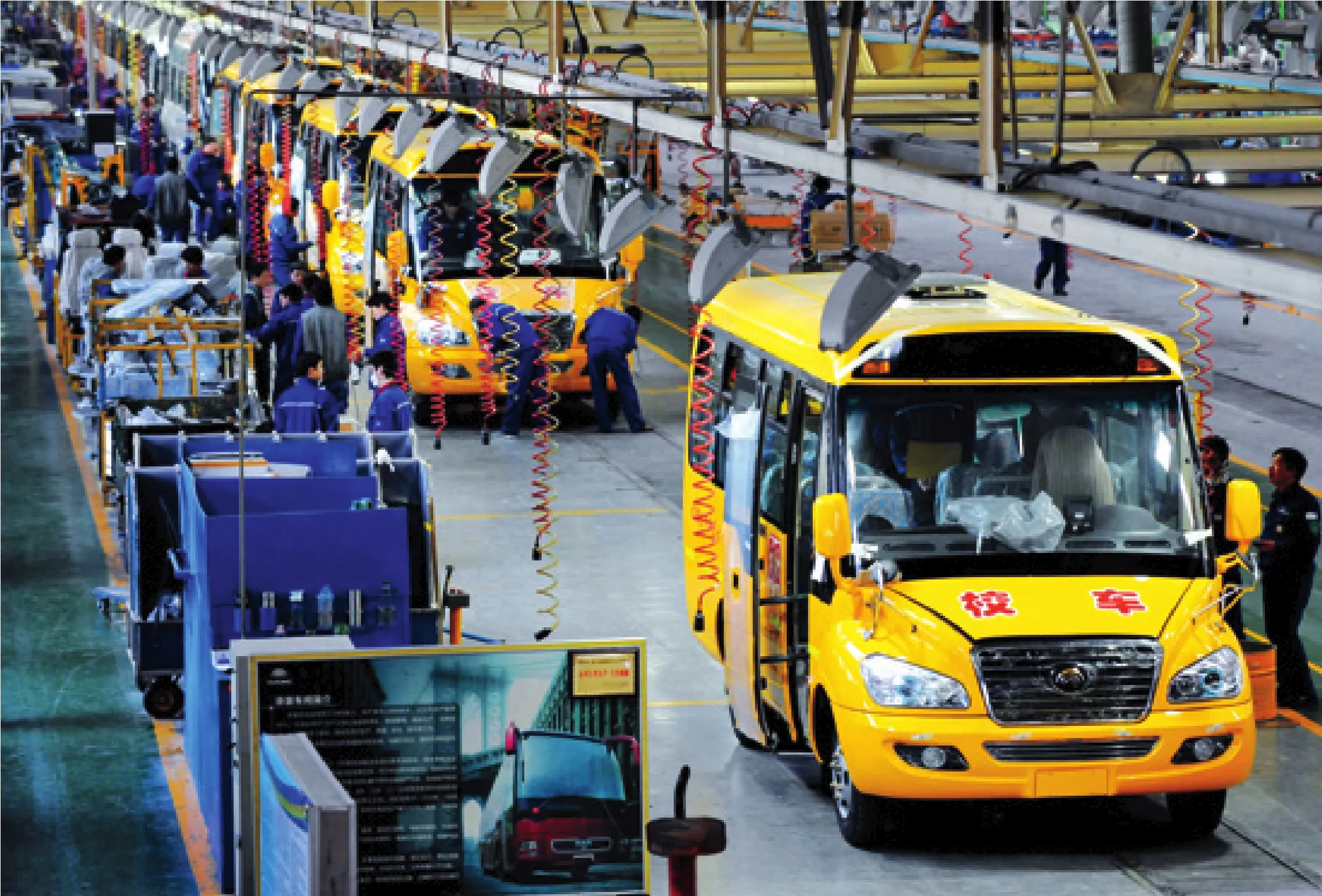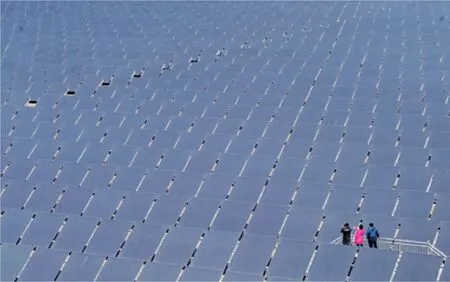The Choice Is Sustainable Development
2013-12-07ByZhangShifuWenYuminLiZongpinChouJianghongMaYiwenSunpenghaoandWangYing
By Zhang Shifu, Wen Yumin,Li Zongpin, Chou Jianghong, Ma Yiwen, Sun penghao and Wang Ying
China has set itself on a path of economic restructuring
‘China, along with the United States,Europe, India and Japan, will become the five engines of world economic development, forging ahead side by side,”said Justin Yifu Lin, a member of the National Committee of the Chinese People’s Political Consultative Conference (CPPCC) and former Chief Economist of the World Bank. On more than one occasion he expressed confidence that China would likely outstrip the United States and Europe to become the world’s largest market by 2030.
Although Lin’s prediction is backed by other global economists, the “Coming Collapse of China” view has also been widely propagated across the world. Western media has even paralleled the hard landing of China’s economy with the deteriorating eurozone debt crisis, aggravating U.S. debt problems, Middle East turmoil and Britain’s withdrawal from the European Union as the five major threats to the world’s economic recovery in 2013.
Will China become an engine for or a threat to the world economy? Things have never been more uncertain since the country began opening up to the outside world.
A rapid rise
In the past three decades with a market economy in place, China has registered an average growth rate of 9.8 percent, and is second to the United States in overall GDP.
As British economist Angus Maddison calculated, China’s GDP accounted for 32.9 percent of the world total in 1820. Beginning in that century, however, China began to lag behind Western countries as the latter continued to industrialize. In 1978, China made up only 4.9 percent of the world’s total GDP. But by 2010,China replaced Japan as the world’s second largest economy and topped the world in exports.
Wu Jinglian, a renowned economist and a member of the CPPCC National Committee, believes credit should go to the entrepreneurship that followed the establishment of a market economy. When the new market system began to take shape, the long-repressed and huge potential for productivity was gradually liberalized,propelling China to achieve rapid economic growth.
Wu’s view echoes that of Liang Xiaomin, a professor from Beijing Technology and Business University. Liang noted that the household contract responsibility system, which was carried out in rural areas when China began reform and opening up, laid a foundation for further reforms and economic development. The emerging of numerous private businesses has injected tremendous vigor into China’s economy, contributing 60 percent to China’s GDP.
Since entering the new century, the soaring economic strength has created a propitious environment for technological innovation, which has in turn added to the country’s economic vitality. Moreover, attention has also been given to the improvement of the legal system, such as the promulgation of Property Law and Patent Law. For all these reasons, Liang also expressed strong con fidence in China’s economy.
Li Daokui, a professor from Tsinghua University and a member of the CPPCC National Committee, expressed a similar viewpoint. Li held that there were two major driving forces for further economic growth. One is the huge consumption potential of a large population, the other is the constant investment in infrastructure projects during the process of urbanization and changes in people’s lifestyle.
Chinese features

CHALLENGING THE SKY:The Shanghai Tower, which is currently under construction, reached 400 meters in height on December 14, 2012
With constant economic expansion, high GDP growth has become increasingly difficult to obtain. The lowest growth rate that China experienced since 1999 was 7.8 percent. In this sense, people tend to believe China will maintain a moderate growth rate ranging from 7 percent to 8 percent in the future.
Also on the minds of many is a dwindling demographic dividend. “Two factors put China’s demographic dividend on the decline,” said Liang. For one thing, GDP growth means higher living standards and higher wages. For another,as the generation born in the 1980s moves into the labor force, the family planning policy established in the 1970s has led to a labor shortage.
According to statistics from the World Bank,the demographic dividend—a period of high economic growth due to a large labor force and low fertility rate—once contributed to 30 percent of China’s economic growth for many years. But now, the figure is falling. Ma Jiantang, Commissioner of the National Bureau of Statistics, predicted that China’s working-age population would experience a steady reduction.
Cao Heping, Associate Dean of School of Economics of Peking University, told reporters at the first sessions of the 12th National People’s Congress and 12th National Committee of the CPPCC that the rising cost of labor makes it difficult to continue exploiting the once-competitive advantage of low labor costs. In the short run, the disappearance of the demographic dividend would significantly pull down corporate profits. In the long run, it is conducive for China to realize sustainable development and quicken the transformation of enterprises. Therefore, at the current stage,China should try to gain dividend from reforms rather than its population by improving labor efficiency and undergoing reforms in its currency and capital markets.
In addition to the absence of the demographic dividend and cost advantage, China for a long time has stuck to an unsustainable growth model—high energy consumption,high emissions and heavy pollution. Su Guocui,a member of the CPPCC National Committee and deputy chief engineer of China Waterborne Transport Research Institute under the Ministry of Transport, argued that when experiencing rapid growth, the environment paid a terrible price. Such a development pattern is not sustainable, and a transformation is urgently needed.

A green book recently published by the Chinese Academy of Social Sciences (CASS)states that since China is now undergoing accelerating industrialization and urbanization,it has taken a lead in energy consumption like oil and coal. In the near future, the country will undoubtedly face surges in energy demand and a widening energy gap. Huge resource and energy consumption will surely result in the high emissions of greenhouse gases. Obviously,the traditional economic growth model is no longer compatible with the goal of sustainable development. For this reason, China is bound to go through a low-carbon transformation.
Ongoing changes
Since the Chinese Government established a strategy of economic restructuring, China, when maintaining stable and rapid development, has also made some progress in growth quality.
The proportion of service industries against GDP rose steadily from 42.6 percent in 2009 to 44.6 percent in 2012.
Domestic demand has become the major driving force for economic growth. In 2012,consumption contributed 51.8 percent to the total economic growth, 1.4 percentage points higher than investment. “The engine for China’s economic growth should shift from investment to consumption,” said Liu Chuanzhi, Chairman of Legend Holdings Ltd., who called for tax reductions to stimulate consumption. “China’s GDP as well as fiscal revenue have maintained rapid growth for years. If the increased revenue goes to people’s pockets,domestic consumption will be significantly boosted.”

NEW ENERGY: visitors tour a model solar power plant built by ENN Group in Langfang, Hebei Province on March 12
In some sectors, overcapacity has been effectively solved, and GDP growth has been less and less dependent on energy consumption. Moreover, in 2011, China outstripped the United States in the number of patent applications received by the State Intellectual Property Office, accounting for one quarter of the world total. In 2012, 54.5 percent of agricultural growth came from technological progress, up from the 53.5 percent in 2011.
Despite some progress, China’s economic restructuring is still confronted with steep challenges and obstacles, like economic inefficiency from a bloated bureaucracy, the absence of policies and subsidies to promote green GDP growth, and excessive intervention in economic development by the government.
“China is at a historical crossroads,” said Wu.“An urgent task now is to promote market-oriented economic reforms and political reforms emphasizing democracy and the rule of law.”
Xia Bin, Honorary Director of Financial Research Institute at the Development Research Center of the State Council, believed what really mattered was whether the government had made up its mind to reform.
Hua Sheng, President of Beijing Yanjing Overseas Chinese University, noted that China’s economic growth was obtained at the cost of environmental degradation. Substantive progress would be difficult to achieve if priority was not given to environmental protection.
Sustainable economic development cannot do without the sustainable development of enterprises. Zhang Ruimin, President of Haier Group, one of the most internationalized and competitive Chinese enterprises, said,“Sustainable development is an eternal objective. But in reality, it may be a paradox.
“The focus is on how to find a correct development path,” he said, adding that some enterprises are drifting toward bankruptcy.
Zhu Xing, a member of the CPPCC National Committee and Assistant Principal of Peking University, stressed that technology should play a bigger role in China’s economic restructuring.Compared with other countries in the world,the contribution of scientific and technological progress to economic growth is relatively low.The lack of independent innovation is a stumbling block in economic restructuring.
The road ahead
According to the report by Hu Jintao, the then General Secretary of the Central Committee of the Communist Party of China (CPC), at 18th CPC National Congress, China should double its 2010 GDP and per-capita income for both urban and rural residents by 2020. Whether China can achieve the goal remains to be seen.
However, observers are optimistic about the future. Zhao Xijun, vice Dean of the School of Finance at Renmin University of China, held that during the 12th Five-Year Plan (2011-15) period, China would experience steady economic expansion at a pace lower than the average 10 percent registered in the past three decades, but still faster than most countries.
Bai Jingming, Deputy Director of Research Institute for Fiscal Science under the Ministry of Finance, held a similar view. “With its macro policies focused on scientific development, China is capable of realizing sustainable development.To this end, a balance should be maintained in environmental protection, efficient resource utilization and economic expansion.”
“Larger investment in energy conservation and environment protection indicate greater support from the government. The Chinese Government has also invested heavily in technological and scientific development,in an effort to fuel its economic restructuring.Apparently, the government has attached great importance to sustainable development.”
Ma Guangyuan, a business commentator,said, “Hu’s report provides detailed enforcement regulations for China’s economic restructuring,making it more feasible and viable. In a decade or two, there is reason to believe China will build up a modern economy, shifting from an economic giant to an economic power.” ■
